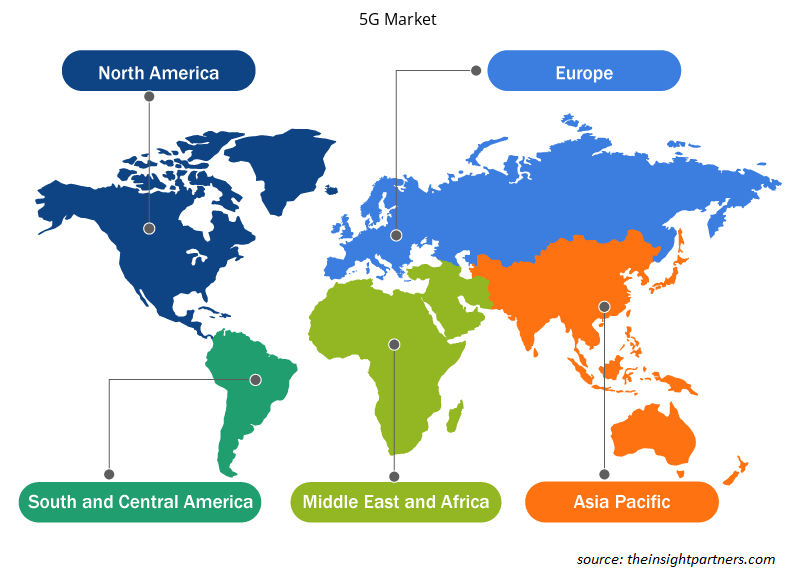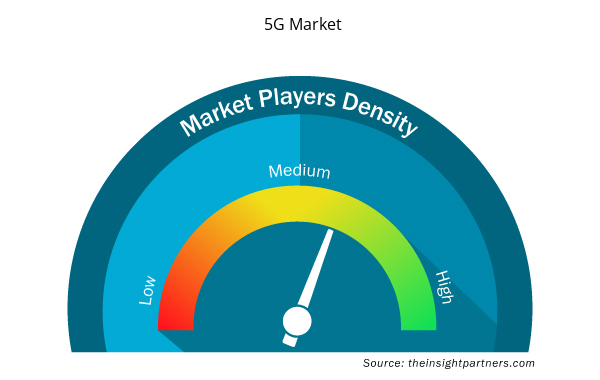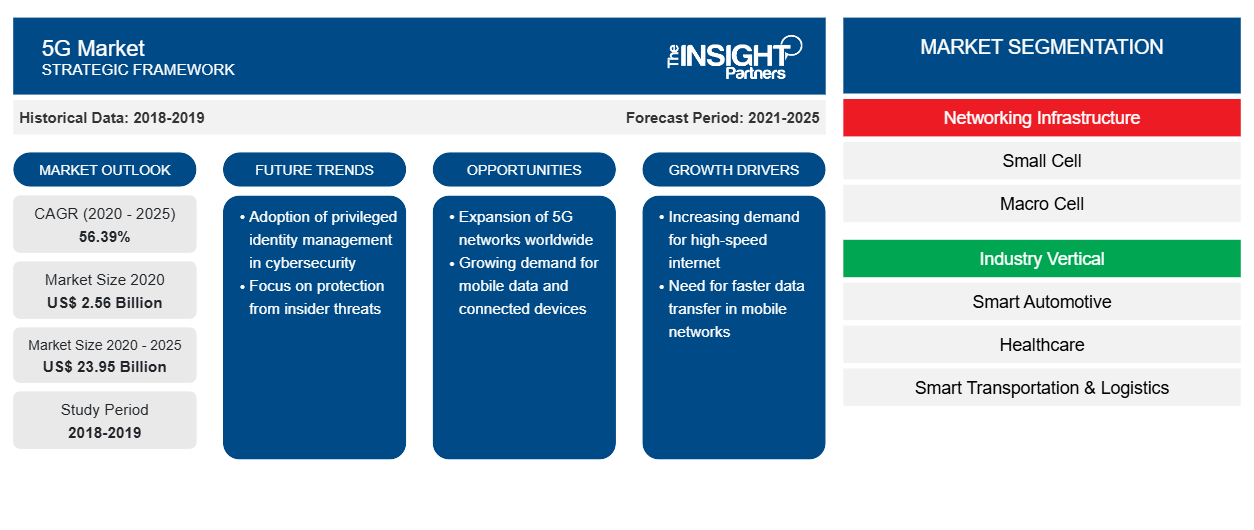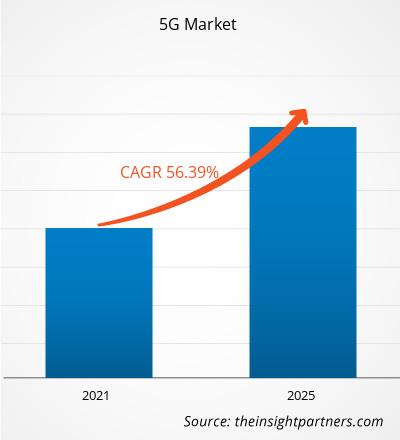Si prevede che il mercato 5G crescerà da 2,56 miliardi di dollari nel 2020 a 23,95 miliardi di dollari entro il 2025, con un CAGR del 56,39% tra il 2020 e il 2025.
Il 5G è impiegato in tre tipi di servizi connessi: banda larga mobile potenziata, comunicazioni mission-critical e un'enorme Internet of Things . La compatibilità in avanti è una caratteristica della tecnologia 5G, il che significa che può essere utilizzata con un'ampia gamma di dispositivi, tra cui smartphone, laptop, sistemi di sicurezza e altro ancora. Ha anche la flessibilità di gestire servizi futuri che richiedono maggiori velocità Internet e latenza ultra-bassa. La tecnologia mobile 5G può inaugurare nuove esperienze immersive come VR e AR con velocità di trasmissione dati più veloci e coerenti, latenza inferiore e costo per bit più economico, oltre a migliorare gli smartphone. Con reti ultra-affidabili, accessibili e a bassa latenza, il 5G può abilitare nuovi servizi in grado di modificare settori, come il controllo remoto di infrastrutture chiave, automobili e operazioni mediche. Inoltre, si prevede che saranno richieste velocità di trasmissione dati più elevate man mano che la domanda di edge computing cresce insieme alla quantità di dati generati dai dispositivi IoT. Pertanto, la crescente penetrazione della tecnologia IoT sta contribuendo alla crescita del mercato 5G.
Si prevede che il mercato globale 5G mostrerà un'elevata crescita nel prossimo futuro. Alcuni dei principali fattori trainanti che contribuiscono alla crescita del mercato includono la crescente necessità di un'infrastruttura di rete di comunicazione efficiente dal punto di vista energetico. Inoltre, si prevede che le crescenti richieste di giunzione di rete sugli aspetti funzionali dell'infrastruttura per ottenere l'efficienza di rete guideranno in modo significativo il settore 5G. Secondo Qualcomm, il 5G è stato implementato in oltre 60 paesi in tutto il mondo e continua a crescere. Secondo l'azienda, il tasso di penetrazione e adozione del 5G è molto più rapido rispetto al 4G. L'aumento della consapevolezza relativa ai vantaggi del 5G sta catalizzando l'adozione della tecnologia, che in definitiva sta dando impulso al mercato 5G. Inoltre, secondo Qualcomm, si prevede che a livello globale un importo di 265 miliardi di dollari USA sarà investito nel settore 5G nei prossimi 15 anni. Grazie al massiccio investimento imminente, si prevede che la crescita del mercato sarà promettente.
Personalizza questo report in base alle tue esigenze
Riceverai la personalizzazione gratuita di qualsiasi report, comprese parti di questo report, o analisi a livello nazionale, pacchetto dati Excel, oltre a usufruire di grandi offerte e sconti per start-up e università
- Scopri le principali tendenze di mercato in questo rapporto.Questo campione GRATUITO includerà analisi di dati che spaziano dalle tendenze di mercato alle stime e alle previsioni.
Approfondimenti sul mercato 5G
Incoraggiare il sostegno e gli investimenti governativi nelle economie in via di sviluppo in tutto il mondo
Diversi paesi in via di sviluppo economico stanno enfatizzando il miglioramento della connettività Internet del paese. Grazie a ciò, gli investimenti nella tecnologia 5G stanno crescendo costantemente, il che sta catalizzando il mercato 5G nei paesi. Ad esempio, il governo dell'Arabia Saudita ha aumentato la sua attenzione sullo sviluppo della tecnologia 5G per raggiungere l'obiettivo VISION 2030 del paese di essere un'economia leader. Le principali società di telecomunicazioni come Ooredoo (Qatar) ed Etisalat Group (EAU) stanno adottando varie misure per far progredire la tecnologia 5G nelle rispettive nazioni. Inoltre, il governo messicano sta lavorando a un progetto chiamato Red Compartida per migliorare la connessione in tutto il paese. L'obiettivo di questo progetto è sviluppare una rete pronta per il 5G in Messico utilizzando la tecnologia LTE. Inoltre, paesi come Argentina, Cile e Colombia hanno adottato misure per investire nella tecnologia 5G attraverso accordi con importanti società di telecomunicazioni come Nokia e Huawei Telecommunications. Pertanto, i fattori sopra menzionati hanno contribuito alla crescita del mercato 5G. Inoltre, l'India è sul punto di lanciare la sua rete 5G, secondo il governo indiano. La tecnologia in India è nella sua fase di sviluppo finale e il governo spera di assistere a un tasso di adozione massiccio nei prossimi 5 anni. Ciò stimolerebbe significativamente il mercato 5G nel paese. Cina e Giappone sono tra i paesi chiave nel mercato 5G asiatico, mentre si prevede che l'India emergerà come uno dei paesi più promettenti nel mercato 5G.
Approfondimenti di mercato verticali basati sul settore
Building & home automation è il settore verticale leader nel mercato. Gli investimenti nella tecnologia smart city dovrebbero raggiungere i 135 miliardi di dollari entro il 2021, secondo IDC. Si prevede che le tecnologie 5G fungeranno da fondamento per le reti small cell che guideranno la prossima generazione di infrastrutture wireless all'interno di una smart city, presentando un'opportunità redditizia per il mercato della tecnologia 5G nel periodo di previsione.
Approfondimenti regionali sul mercato 5G
Le tendenze regionali e i fattori che influenzano il mercato 5G durante il periodo di previsione sono stati ampiamente spiegati dagli analisti di Insight Partners. Questa sezione discute anche i segmenti e la geografia del mercato 5G in Nord America, Europa, Asia Pacifico, Medio Oriente e Africa e Sud e Centro America.

- Ottieni i dati specifici regionali per il mercato 5G
Ambito del rapporto sul mercato 5G
| Attributo del report | Dettagli |
|---|---|
| Dimensioni del mercato nel 2020 | 2,56 miliardi di dollari USA |
| Dimensioni del mercato entro il 2025 | 23,95 miliardi di dollari USA |
| CAGR globale (2020 - 2025) | 56,39% |
| Dati storici | 2018-2019 |
| Periodo di previsione | 2021-2025 |
| Segmenti coperti | Per infrastruttura di rete
|
| Regioni e Paesi coperti | America del Nord
|
| Leader di mercato e profili aziendali chiave |
|
Densità degli attori del mercato: comprendere il suo impatto sulle dinamiche aziendali
Il mercato del 5G sta crescendo rapidamente, spinto dalla crescente domanda degli utenti finali dovuta a fattori quali l'evoluzione delle preferenze dei consumatori, i progressi tecnologici e una maggiore consapevolezza dei vantaggi del prodotto. Con l'aumento della domanda, le aziende stanno ampliando le loro offerte, innovando per soddisfare le esigenze dei consumatori e capitalizzando sulle tendenze emergenti, il che alimenta ulteriormente la crescita del mercato.
La densità degli operatori di mercato si riferisce alla distribuzione di aziende o società che operano in un particolare mercato o settore. Indica quanti concorrenti (operatori di mercato) sono presenti in un dato spazio di mercato in relazione alle sue dimensioni o al valore di mercato totale.
Le principali aziende che operano nel mercato 5G sono:
- T-Mobile USA, Inc.
- Cisco Systems, Inc.
- Società a responsabilità limitata AT&T
- Qualcomm, Inc.
- Ericsson
Disclaimer : le aziende elencate sopra non sono classificate secondo un ordine particolare.

- Ottieni una panoramica dei principali attori del mercato 5G
Gli operatori che operano nel mercato 5G adottano strategie quali fusioni, acquisizioni e iniziative di mercato per mantenere le loro posizioni nel mercato. Di seguito sono elencati alcuni sviluppi da parte degli operatori chiave:
- Nel 2018, AT&T ha firmato un accordo con Crown Castle International Corp. per espandere e semplificare il loro contratto di leasing continuativo per l'infrastruttura di rete wireless. Queste operazioni di leasing e gestione sono modernizzate per migliorare la flessibilità e l'efficienza implementando nuove tecnologie e aumentando la capacità di rete.
- Nel 2018, Cisco ha annunciato la sua collaborazione con Saudi Telecom Company (STC) per lo sviluppo di sistemi e reti di comunicazioni 5G in Arabia Saudita. In base a questo accordo, Cisco trasformerà lo sviluppo della prospettiva commerciale delle reti mobili 5G.
- Analisi storica (2 anni), anno base, previsione (7 anni) con CAGR
- Analisi PEST e SWOT
- Valore/volume delle dimensioni del mercato - Globale, regionale, nazionale
- Industria e panorama competitivo
- Set di dati Excel


- Identity Verification Market
- Equipment Rental Software Market
- Animal Genetics Market
- Sweet Potato Market
- Aircraft Wire and Cable Market
- Semiconductor Metrology and Inspection Market
- Thermal Energy Storage Market
- Emergency Department Information System (EDIS) Market
- Data Annotation Tools Market
- Digital Pathology Market

Report Coverage
Revenue forecast, Company Analysis, Industry landscape, Growth factors, and Trends

Segment Covered
This text is related
to segments covered.

Regional Scope
North America, Europe, Asia Pacific, Middle East & Africa, South & Central America

Country Scope
This text is related
to country scope.
Trends and growth analysis reports related to Technology, Media and Telecommunications : READ MORE..
The List of Companies
1. T-Mobile USA, Inc.
2. Cisco Systems, Inc.
3. AT&T, Inc.
4. Qualcomm, Inc.
5. Ericsson
6. Huawei Technologies Co. Ltd.
7. Verizon Communications, Inc.
8. Nokia Networks
9. Telefonica S.A.
10. Orange S.A.
The Insight Partners performs research in 4 major stages: Data Collection & Secondary Research, Primary Research, Data Analysis and Data Triangulation & Final Review.
- Data Collection and Secondary Research:
As a market research and consulting firm operating from a decade, we have published and advised several client across the globe. First step for any study will start with an assessment of currently available data and insights from existing reports. Further, historical and current market information is collected from Investor Presentations, Annual Reports, SEC Filings, etc., and other information related to company’s performance and market positioning are gathered from Paid Databases (Factiva, Hoovers, and Reuters) and various other publications available in public domain.
Several associations trade associates, technical forums, institutes, societies and organization are accessed to gain technical as well as market related insights through their publications such as research papers, blogs and press releases related to the studies are referred to get cues about the market. Further, white papers, journals, magazines, and other news articles published in last 3 years are scrutinized and analyzed to understand the current market trends.
- Primary Research:
The primarily interview analysis comprise of data obtained from industry participants interview and answers to survey questions gathered by in-house primary team.
For primary research, interviews are conducted with industry experts/CEOs/Marketing Managers/VPs/Subject Matter Experts from both demand and supply side to get a 360-degree view of the market. The primary team conducts several interviews based on the complexity of the markets to understand the various market trends and dynamics which makes research more credible and precise.
A typical research interview fulfils the following functions:
- Provides first-hand information on the market size, market trends, growth trends, competitive landscape, and outlook
- Validates and strengthens in-house secondary research findings
- Develops the analysis team’s expertise and market understanding
Primary research involves email interactions and telephone interviews for each market, category, segment, and sub-segment across geographies. The participants who typically take part in such a process include, but are not limited to:
- Industry participants: VPs, business development managers, market intelligence managers and national sales managers
- Outside experts: Valuation experts, research analysts and key opinion leaders specializing in the electronics and semiconductor industry.
Below is the breakup of our primary respondents by company, designation, and region:

Once we receive the confirmation from primary research sources or primary respondents, we finalize the base year market estimation and forecast the data as per the macroeconomic and microeconomic factors assessed during data collection.
- Data Analysis:
Once data is validated through both secondary as well as primary respondents, we finalize the market estimations by hypothesis formulation and factor analysis at regional and country level.
- Macro-Economic Factor Analysis:
We analyse macroeconomic indicators such the gross domestic product (GDP), increase in the demand for goods and services across industries, technological advancement, regional economic growth, governmental policies, the influence of COVID-19, PEST analysis, and other aspects. This analysis aids in setting benchmarks for various nations/regions and approximating market splits. Additionally, the general trend of the aforementioned components aid in determining the market's development possibilities.
- Country Level Data:
Various factors that are especially aligned to the country are taken into account to determine the market size for a certain area and country, including the presence of vendors, such as headquarters and offices, the country's GDP, demand patterns, and industry growth. To comprehend the market dynamics for the nation, a number of growth variables, inhibitors, application areas, and current market trends are researched. The aforementioned elements aid in determining the country's overall market's growth potential.
- Company Profile:
The “Table of Contents” is formulated by listing and analyzing more than 25 - 30 companies operating in the market ecosystem across geographies. However, we profile only 10 companies as a standard practice in our syndicate reports. These 10 companies comprise leading, emerging, and regional players. Nonetheless, our analysis is not restricted to the 10 listed companies, we also analyze other companies present in the market to develop a holistic view and understand the prevailing trends. The “Company Profiles” section in the report covers key facts, business description, products & services, financial information, SWOT analysis, and key developments. The financial information presented is extracted from the annual reports and official documents of the publicly listed companies. Upon collecting the information for the sections of respective companies, we verify them via various primary sources and then compile the data in respective company profiles. The company level information helps us in deriving the base number as well as in forecasting the market size.
- Developing Base Number:
Aggregation of sales statistics (2020-2022) and macro-economic factor, and other secondary and primary research insights are utilized to arrive at base number and related market shares for 2022. The data gaps are identified in this step and relevant market data is analyzed, collected from paid primary interviews or databases. On finalizing the base year market size, forecasts are developed on the basis of macro-economic, industry and market growth factors and company level analysis.
- Data Triangulation and Final Review:
The market findings and base year market size calculations are validated from supply as well as demand side. Demand side validations are based on macro-economic factor analysis and benchmarks for respective regions and countries. In case of supply side validations, revenues of major companies are estimated (in case not available) based on industry benchmark, approximate number of employees, product portfolio, and primary interviews revenues are gathered. Further revenue from target product/service segment is assessed to avoid overshooting of market statistics. In case of heavy deviations between supply and demand side values, all thes steps are repeated to achieve synchronization.
We follow an iterative model, wherein we share our research findings with Subject Matter Experts (SME’s) and Key Opinion Leaders (KOLs) until consensus view of the market is not formulated – this model negates any drastic deviation in the opinions of experts. Only validated and universally acceptable research findings are quoted in our reports.
We have important check points that we use to validate our research findings – which we call – data triangulation, where we validate the information, we generate from secondary sources with primary interviews and then we re-validate with our internal data bases and Subject matter experts. This comprehensive model enables us to deliver high quality, reliable data in shortest possible time.


 Ottieni un campione gratuito per questo repot
Ottieni un campione gratuito per questo repot